
Article & Video by Dave Howell & Dan McCain of 7 Shot Tennis in August 2022
When 18 year old Coco Gauff reached the final round of the 2022 French Open at Roland Garros, many of us were excited to see what she could do on this occasion, her first major final. Well, Iga Swiatek was on a roll too and ended Coco’s dreams in short order, 6-1, 6-3.
Conventional wisdom says Gauff has problems with her serve and her forehand. While conventional wisdom is almost always quick to criticize, it rarely solves problems.
Kathy Giusti is 64 years old. Does that name ring a bell? Wasn’t she one of those phenom Florida junior players from the 70’s? Didn’t she beat everyone a couple of age groups ahead of her, turned pro early, made a bit of a splash, but that was about it?
Actually Kathy Giusti is none of those things. But, as a business leader & healthcare disruptor, Kathy Giusti knows how to solve a big problem.
The statistics we have compiled at 7 Shot Tennis show that Coco has significant room for improvement on her serve and forehand. The issues she has with forehands and serves can be improved by following Kathy’s problem solving process.
- Take a look at things
- Compile data
- Figure out what the problem is
- Create a solution
- Articulate it
- Implement it
Using Tennis Channel Plus, I looked at all of her matches from the 2nd round through to the French Open final of this year’s event. Then I compiled data from each match using a tool we’ve developed at 7 Shot Tennis.
The image below illustrates the 7 Shot Tennis Tactical Positions. It is very similar to what the ITF (and other entities) has presented to coaches for decades, which is the D.N.O. Model (Defense, Neutral and Offense). We like our model better because it contains more detail.
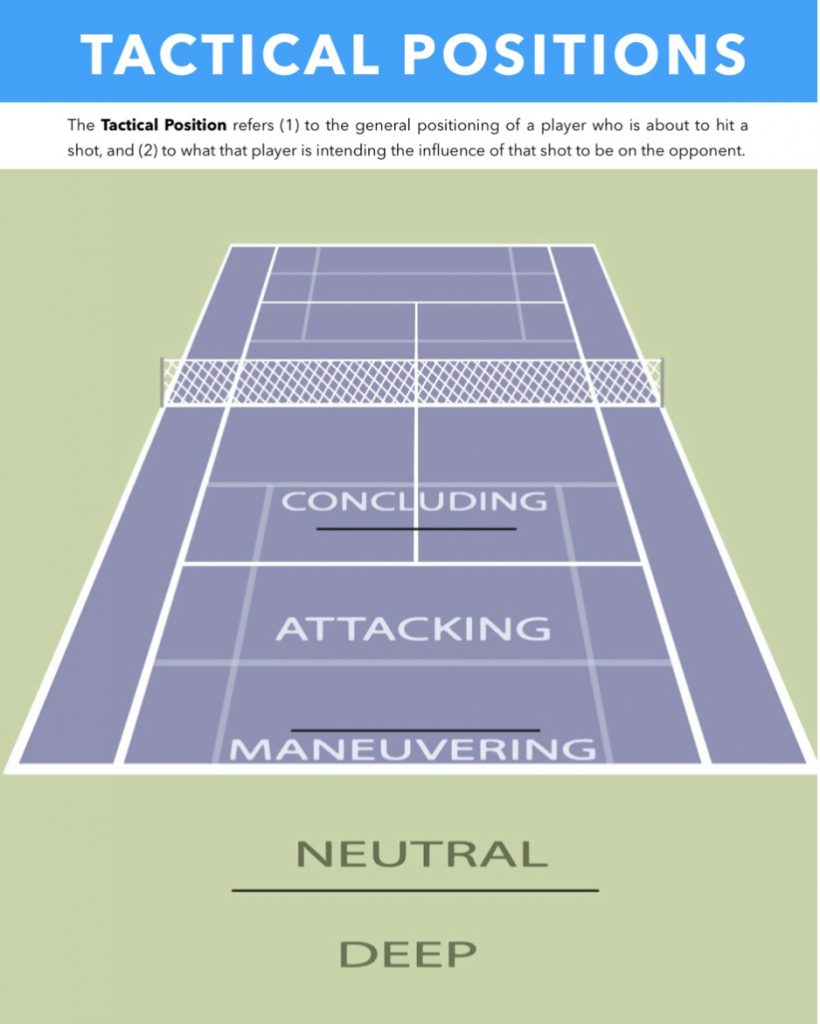
Our Tactical Positions, when used in concert with our Target Areas, enable us to track 2 key things that make 7 Shot Tennis unique: where a shot went and where it was hit from.
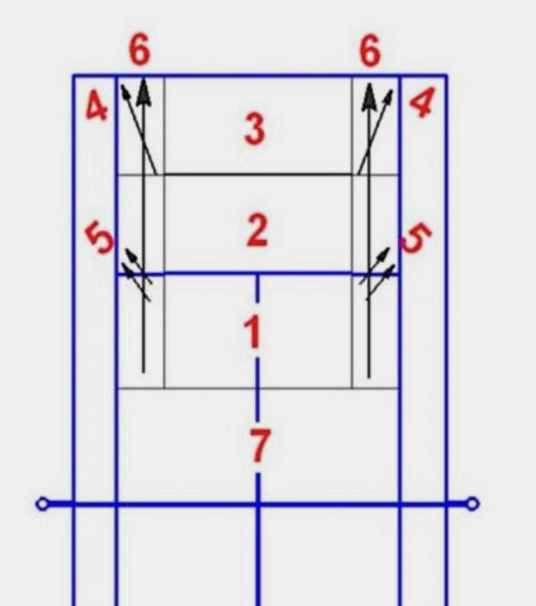
From charting Coco’s matches at 2022 Roland Garros, our data shows that she had particular trouble with neutral forehands – certainly enough to cost her the final. This article focuses on that specifically and provides simple solutions.

When we chart matches at 7 Shot Tennis, all Point-Ending shots are recorded as either a Plus or a Minus.
There are 3 Plus Effects: a Winner (W), a Forcing Shot (X) and Fluke (Y). A Forcing Shot is a good shot that results in a forced error by the opponent, whereas a fluke is what your common sense may tell you – it’s a shot that you got lucky on, like a net cord winner, a bad bounce that causes that opponent to miss, etc.
There is only 1 Minus Effect: Unforced Error (U). At the end, we provide a summary of the match. We refer to that summary as a Tactical Breakdown.
We create Tactical Breakdowns for matches that provide an overview of player performances in each tactical position, which tells the story of what really happened throughout a match. The image below introduces how they work.
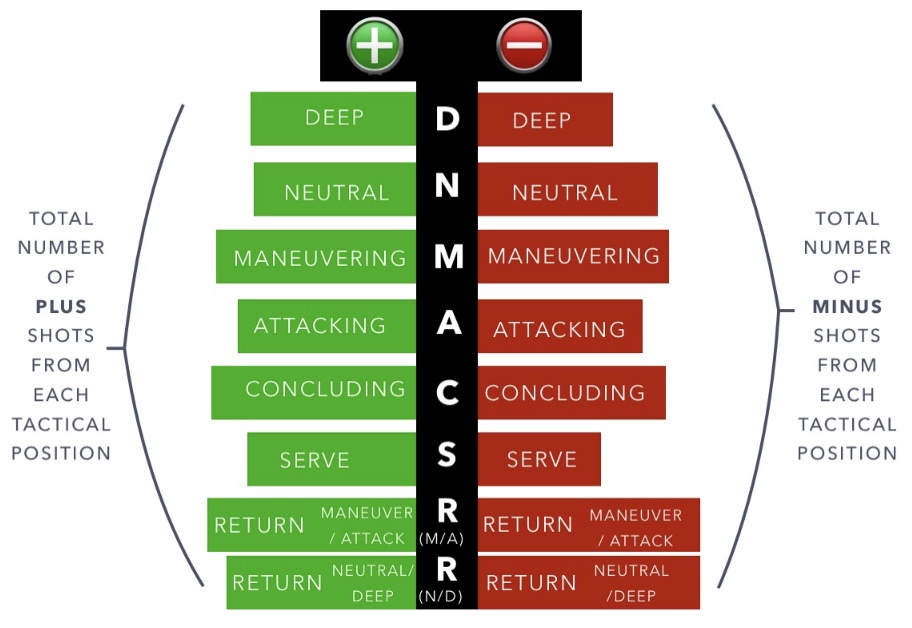
Roland Garros Final 2022 Tactical Breakdown: Coco vs. Iga
The Tactical Breakdown below shows a side by side comparison of point ending pluses and minuses hit from each tactical position of the court through the entirety of the French Open final between Coco Gauff and Iga Swiatek.
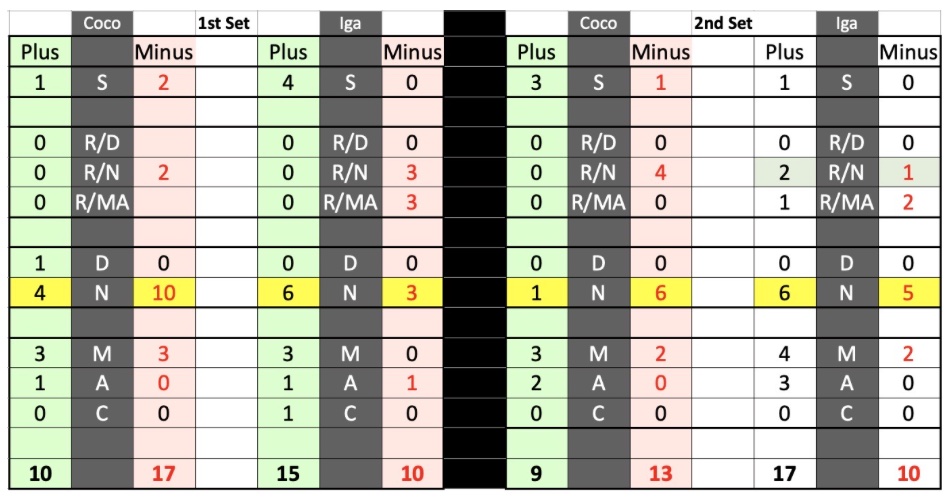
Stats from the Tactical Breakdown of the final illustrate that Coco was way behind in the neutral position, especially in the 1st set.
The Tactical Breakdown below shows what happened in the 1st set.
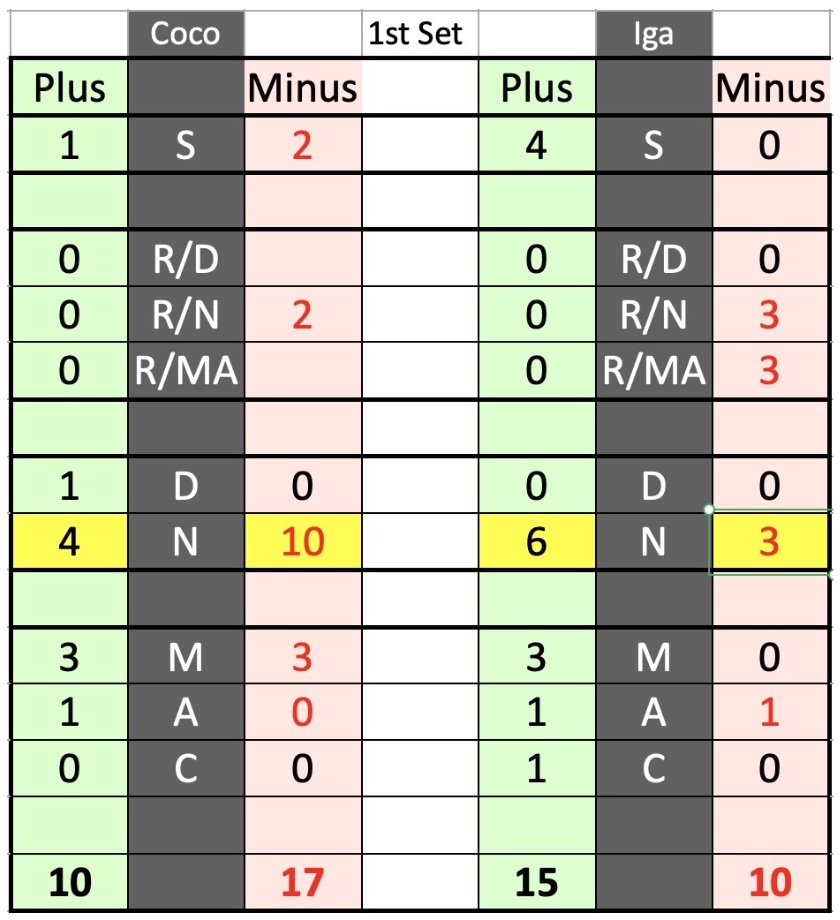
In 7 Shot Tennis, a shot is described as a Stroke + a Target area (where the stroke was hit to) + a Tactical Position (where the shot was hit from).
A Shot = a Stroke + a Target + a Tactic.
Because of Coco’s significant statistical discrepancy in neutral positions, more data was needed. I reviewed the Box Score looking for points that ended with shots hit from the Neutral tactical area. I wanted to know what stroke she was missing whether those shots ended up in the net, or landed wide or long of a Target area. Maybe I might find some kind of pattern or some type of shot she was consistently missing.
The Box Score revealed that of the 10 unforced errors (U) Coco made on neutral ground in the 1st set, 9 were forehands. Only 1 was a Plus.
The 7 Shot Tennis Box Score below illustrates all of the point-ending shots in Coco’s 1st set performance.
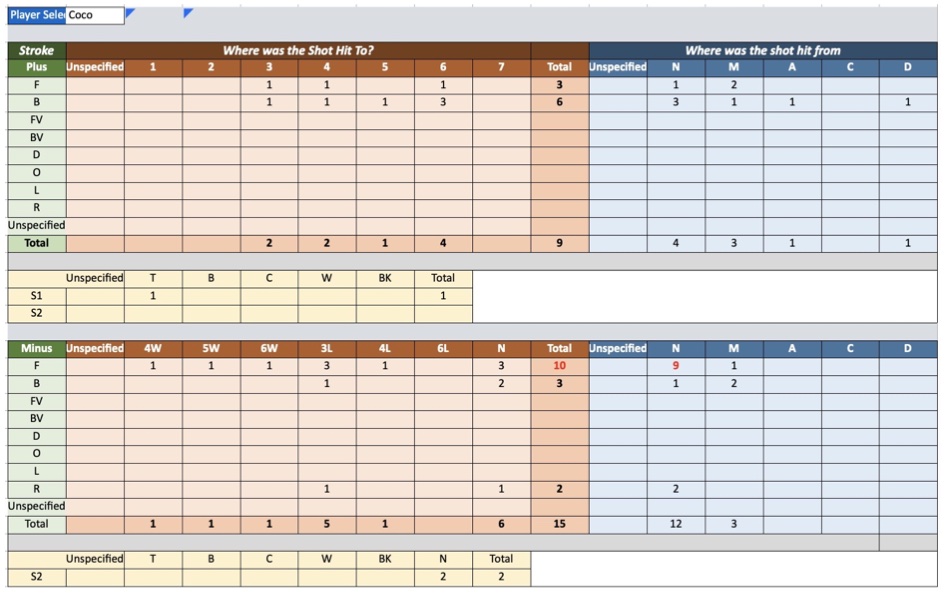
From this box score data, I created the image below for a closer look at Coco’s overall forehand metrics in the 1st set. This shows the 3 pluses and 10 minuses (9 of which were in neutral positions).

Now it was time to go to the 7 Shot Scorecard to find when each of these points occurred so I could look at them again. The great thing about video is you can watch points again and again, each time seeing something more. After watching these points again, and for most, more than once, I could see that the problems Coco was having were becoming more magnified.
I passed this information over to Dan McCain. Watch the video he produced to see how techniques he developed for his books How the Tennis Gods Move and Functional Training For Tennis are applied to create a solution for Coco.
After watching the video (and you can watch it more than once), read how Dan articulates a solution (below).
After reviewing this report and the accompanying video, the final step is for Coco and her team to implement the solution if they so choose.
Technical Solution
This video shows 9 different neutral forehand errors made by Coco Gauff in the 1st set of the 2022 French Open Final against Iga Swiatek. The majority of these are Technical Errors (mechanics) and 1 was a Tactical Error (poor shot selection).
The bad news is she was missing those neutral forehands to targets all over the place. The good news is they are all for the same couple of reasons.
It would not be difficult to argue that neutral forehands cost her a grand slam title. The video below hopefully makes her technical issues pretty obvious both to see and to fix, especially with the side by side comparisons to other pros.
The explanation below spells out the technical problems, the solutions and the benefits of adopting them.
Technical Errors vs. Tactical Errors
In the straightforward world of 7 Shot Tennis, a Technical Error refers to an error made that was caused by a breakdown in mechanics. A Tactical Error refers to an error made that was caused by an ill-advised or low-percentage shot selection.
To easily explain why the errors made by Gauff in this video are largely Technical Errors, we can use the 7 Stages of Every Stroke to outline clear technical fundamentals that happen sequentially in every fundamentally sound forehand.
Here’s a quote from Tim Mayotte (who also learned these 7 stages from Lee Hurst during our time coaching for the USTA) that illustrates these 7 Stages:
“The 1st Stage is the Split Step for movement and the Ready Position for the racket. The 2nd Stage is the Unit Turn and the Grip Change, if needed. The 3rd Stage is the Footwork Pattern and the Racket Preparation, also called the take-back. The 4th Stage is Loading and the racket enters what we call “the Pull Position,” which is its path forward. The 5th Stage is Unloading and the racket goes to Contact (the ball). The 6th Stage is when the racket goes to Finish and there is a Reorientation of the Feet. The 7th Stage is Recovery and back to the ready position.”
Within the 7 Stages, Coco Guaff shows significant technical deficiencies in the 5th Stage (the Unloading) and especially the 6th stage (the racquet finish coinciding with the reorientation of the feet).
In regards to the 5th Stage – the Unloading:
Since it’s her forehand, this unloading largely refers to shoulder and hip rotation during the forward swing to finish. Most or even perhaps all of the neutral forehand errors shown in this video either show limited trunk rotation and/or that which is disconnected to the forward swing through impact and the finish.
Once a player loads into a stance, 2 important things happen – the forward swing through to finish and the trunk rotation. Should those 2 things happen separately or at the same time?
What do Federer and other pros with great, fundamentally sound forehands do? See for yourself here and here.
In regards to the 6th Stage – the Racquet Finish Coinciding with the Reorientation of the Feet:
Applying the concept of linear momentum to a player’s movement can simply explain this. Gauff’s movement preparation in many – if not all of her errors in the video – is pretty good.
The problem is not how she moves to these shots – the problem is how she moves through these shots – or rather how she doesn’t. Because she improperly decelerates her momentum, her dynamic balance is heavily affected.
The 5th and the 6th stages influence each other in every forehand hit by every player, and Gauff is no different. To say that a player’s limited trunk rotation may be influenced by losing any amount of dynamic balance would be a pretty non-controversial statement. In the case of Gauff’s neutral forehand errors, this is a common entanglement.
By rotating poorly and not moving through her shot properly, her contact point quality, swing shape execution, overall dynamic balance, and thus both accuracy and power generation are all negatively affected.
This article by Mark Kovacs illustrates that we at 7 Shot Tennis are not alone in our firm belief in the importance of efficient movement and deceleration.
When a player exhibits deficiencies in the 5th and 6th stages of a stroke, the 7th stage will also be affected. But it’s not just the fact that Gauff doesn’t move through these forehands – she kind of does. It’s her unwillingness to do so. This unwillingness misses out on a key detail that many top pros spend time obsessing over. They obsess over not just moving through their forehands and other shots – but also how they do it.
There are important details with how a player moves through a shot – the 6th stage – that affects the 7th stage – which is the recovery for the next shot.
Because this stuff negatively affects her dynamic balance and her ability to recover efficiently, it negatively affects her next shot by reducing the amount of time she has to execute it.
How Federer and Djokovic, for example, move through their forehands not only affects the quality of their forehands because it affects the quality of their trunk rotation and facilitates dynamic balance – it also significantly affects their next shot too. A balanced, immediate and even explosive recovery for the next shot sets the stage toward maximizing the amount of available time they have to hit their next shot – whatever it may be.
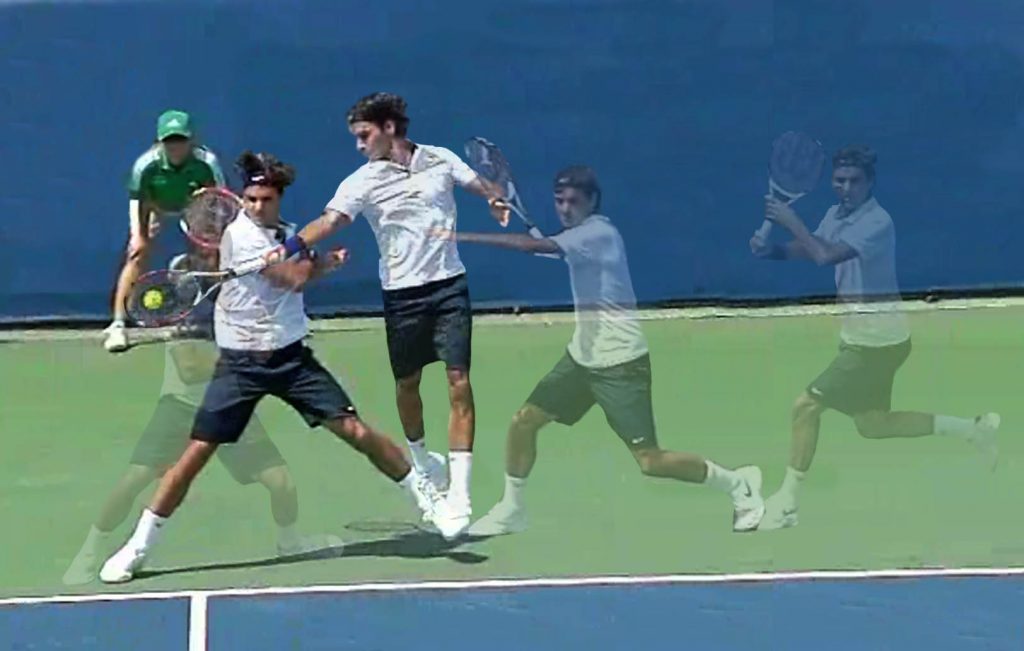
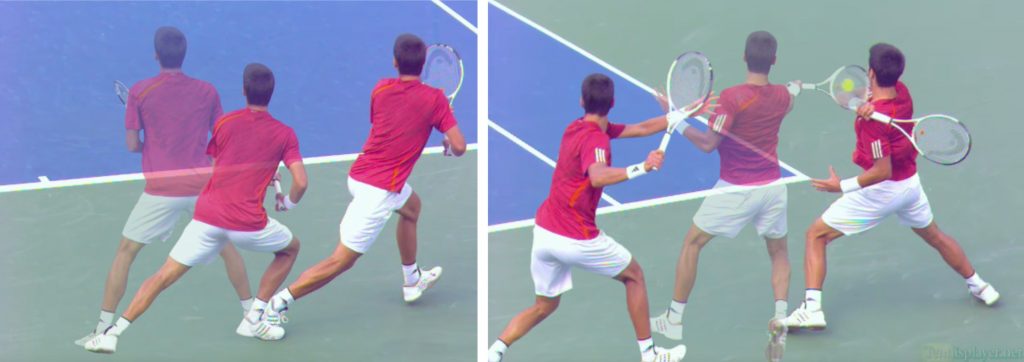
More time for the next shot means a greater potential for taking greater control of the point. This also means a far greater potential for playing at a higher level.
This reminds me of a great video posted by Johnny Parkes, working with the Aussie top 100 pro Thanasi Kokkinakis at IMG. No tennis balls. Just shadowing lateral movement to his right on neutral forehands. The only thing they were tirelessly working on was how he moves through his forehands. The detail they were obsessing over was finishing with his outside leg – his right foot specifically – a little ahead of his left foot – so he could maximize the efficiency of his recovery by starting his recovery with a crossover step.
This is clearly something Coco has never trained, but it’s a skill that can certainly be acquired. This 7 second video shows a player I worked with for many years working on this when he was 11. The ebook Functional Training for Tennis shows a range of simple methods on how to train this.
To Summarize:
If Coco Gauff improves how she rotates and moves through her forehand, she can receive significant benefits. By developing / refining these vital fundamentals, her forehand will improve, as will her overall movement efficiency. With those additions, her entire level of play could see a significant boost.
She’s already made a grand slam final. What if her forehand evolved from a liability to major strength?
The answers are right here in black and white. And on video.
